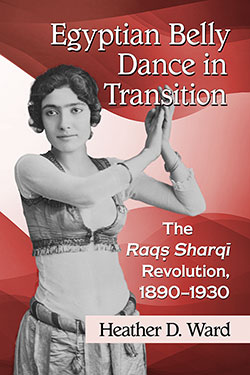
Egyptian Belly Dance in Transition: The Raqṣ Sharqī Revolution, 1890–1930
Tom Verde
Heather D. Ward
2018, McFarland Books, 978-1-47666-674-7, $39.95 pb.
Cultural historians have asserted that raqṣ sharqī (eastern dance)—public interpretations of raqṣ baladi (belly dance) performed at private celebrations like weddings—evolved during the British colonial era in Egypt in the late 19th and early 20th centuries in response to Western influences and desires, Ward writes in this study of the often-stereotyped art form. She argues that raqṣ sharqī was in fact a rebellion against foreign occupation, “a product of Egyptians actively defining and asserting their cultural and national identity.” Drawing on Arabic primary sources including accounts by “Egyptians who created the dance themselves,” the book takes readers into the Arab-owned, colonial-era entertainment halls where raqṣ sharqī was presented. We learn that the outfit worn by dancers was not “a Western fantasy costume,” but descended from “an indigenous (though Ottoman-influenced) … style.” What was seen on stage was not some titillating Orientalist vision, “but hybrid cultural expressions … embraced as authentically Egyptian.”
You may also be interested in...

Children's Book Offers Lessons for Any Age
Change is hard, and there are few bigger changes to contend with than that of moving thousands of kilometers away to a different country.
Naguib Mahfouz Medal for Literature Winner Gives Voice to Marginalized
“No one else will be destined to write a life story as squalid as mine, although it’s all true,” comments the elusive protagonist of Algerian author Ahmed Taibaoui’s noir novel.
British Museum Curator Takes Readers on Journey Spanning 6,000 Years
Southeast Asia curator Alexandra Green takes readers on a journey spanning 6,000 years, highlighting objects from Neolithic stone tools to contemporary paintings.